Copyright 2020 - 2021 irantour.tours all right reserved
Designed by Behsazanhost
Top 10 oldest mosques in Iran
Top 10 oldest mosques in Iran
Iran boasts a rich complex of historical mosques by the name Iranian-Islamic Mosques, that stand as testaments to Iran historical and architectural heritage. These historical mosques serve as prominent landmarks and iconic symbols of the deep country-rooted Islamic culture. These historical and famous mosques steeped in centuries of Iran history. They show Iran traditional arts, Persian architecture, religious arts, and are a window into the past of country.
The Iranian old mosques that scattered throughout Iran have some different roles than worship places. These treasures that narrate tales of bygone eras not only serve as religious centers but also as cultural hubs that echoes Iran history. Each mosque bears the marks of different eras, reflecting the diverse artistic and architectural influences that have shaped Iran over the years.
Exploring Iranian mosques is a journey back in time. They provide a glimpse to Iranian architecture evolution and the impact of the Islam's presence in Iran architecture. These historical Islamic sites are not just a structures, they are live testimonies to the faith, artistry, and craftsmanship of generations past. Their intricate designs, ornate decorations, and spiritual significance make them iconic landmarks that magic all visitors.
The architectural heritage mosques of Iran are not only marvels of construction but also symbols of the country’s religious and cultural identity. These traditional mosques have a main role as historic religious buildings that hold a special place in the hearts of the Iranian people.
They are more than a landmarks, they are sanctuaries of peace and tranquility that embody the spirit of Iran’s landmark mosques.They have Iranian-Islamic architecture forms, and among all mosques, some have original Iranian-Arabic roots, indicating the Iran's evolution mosques from 1,200 years ago to the present.
 |
The most famous Iranian Mosques are:
1-Tari khaneh Mosque: The Oldest Mosque in Iran
The Tarikhaneh Temple or the Tari khaneh Mosque is a Sassanid-era monument and one of the oldest Iran's mosque, located in the city of Damghan, Semnan Province, Iran. This mosque mentioned as the oldest one in Iran. A mosque built on the remains of a Sassanid fire temple. Tari Khane, or "God's House' is a combination of the Arabic mosque plans with Sasanian architectural techniques. The plan of the mosque consists of a square courtyard that is surrounded by arches of barrel vaults in 3.5 meters high and almost 2 meters and supported by slightly pointed brick arches fired on rather squat circular pillars, typical of Sassanid architecture.
What to see in Mosque
Courtyard (central courtyard)
The courtyard of this mosque is almost square, 27 meters long and 27 meters wide, without a pond. It is surrounded by covered porticoes (22 porticoes) with striking arches and circular columns.
Shabestan Mosque
The nave of this mosque is on the southwest side (in the direction of Qiblah) and is in the form of a pillared hall. The number of columns in this hall are 26. These columns are circular and similar to the columns of Sassanid palaces. Their diameter is 1.5 meters and the circumference of each column is about 5 meters.
Minaret
This mosque has a minaret with a height of 26 meters, which its body decorated with the most beautiful and eye-catching brickworks.
Why Damghan City
- The capital of Parthian Empire.
- Low distance to Tehran(210 KM).
- Vast and beautiful Pistachio orxhards.
- The second center of Pistachio production(21000 tons).
- Different historical monuments from 2000 year-ago.
- Tape Hesar one of the most famous Iran's ancient hills.
How to get there
There are various Bus schedule transportation from Tehran to Semnan and Damghan cities. You can book your bus Ticket with US$ 2.
Where to stay
There is one 3-star hotel in Damghan city. But if you are eager to stay at an eco-lodge house there are various options to stay.
You can selet one of them from US$ 7 (for 4 pax).
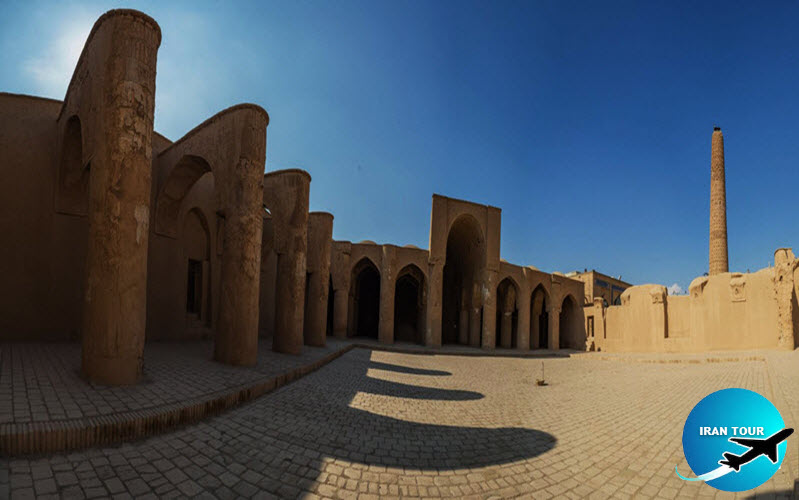 |
2-Saveh Jame Mosque: The Gem of Red Ruby City
If you are looking to explore one of Iran’s top 10 historic mosques, the Saveh Jame Mosque near Tehran is a must-visit destination. Located amidst the picturesque pomegranate gardens of Saveh City, this mosque stands out as one of the most striking architectural wonders in the region.
Saveh known as the “Red Ruby City” due to its abundance lush pomegranate orchards, making it a truly enchanting place to visit. Besides the Saveh Jame Mosque, the city is home to a plethora of historical landmarks, agricultural gardens, recreational spots, and the fascinating Ave underground city. It has become a popular tourist hotspot near Tehran, offering a blend of natural beauty and rich cultural heritage.
The Saveh Jame Mosque, an ancient gem among Iran old mosques, showcases a unique blend of Iranian and Islamic architectural styles, presenting visitors with a serene and awe-inspiring Islamic masterpiece. If you seek to immerse yourself in the rich history and artistry Iranian mosques, the Saveh Jame Mosque should be at the top your list.
Architecture and design
The architectural marvel of the Saveh Jame Mosque is a sight to behold, boasting a captivating blend of intricate design elements and exquisite decorations that showcase the rich artistic heritage of Iran.The Saveh historical Jame Mosquea forces the visitors to admire this eye-cathcing monument with a series of stunning features, including well-crafted courtyards, elegant porches, a majestic minaret, intimate prayer spaces, a grand dome, and two ancient altars adorned with inscriptions in Kufic script.
The open rectangular courtyard, measuring 36x44 meters, encircled by brick columns, adding a sense of grandeur to the structure.The main dome with 16 meters high and spans 14 meters in diameter, is the focal point of mosque’s design. Internally, the dome adorned with crafted tile work and mosaic patterns, creats a mesmerizing display that captivates the imagination of all who enter.
The only minaret of the mosque, with 14 m height is a masterpiece of Seljuk period architectural. Its exquisite design features a remarkable array of raised brick patterns and intricate inscriptions in Kufic and Naskhi scripts, making it a standout example of Seljuk craftsmanship that has stood the test of time.
Why we suggest Save City
- Low distance to Tehran(140 km).
- A good destination for one-day excursion tour.
- Various historical sites and monuments from 2000 year- ago.
- Various Pomegrant orchards all over the city.
- Ave underground city dating back to 2000 years ago.
- Various tourist destination villages.
How to get there
Many buses leave Tehran's West, South, East and Argentina terminals to Saveh every day.You can buy your ticket from US$ 2.
Where to stay
Although the city of Saveh hasn't many hotels, you can choose one of the traditional residences and experience a memorable night in traditional Iranian eco-lodges.
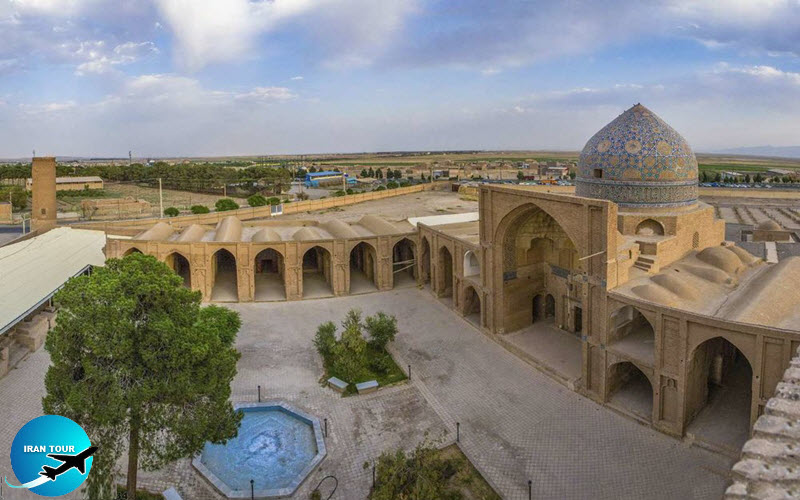 |
3-Zavare Jame Mosque: A Unique Art-work of Seljuk Architects
If you are looking to explore some of Iran’s most captivating historical sites and monuments on your journey from Kashan city to Isfahan, Zavare Village should be at the top of your list. This village boasts a rich history and offers an array of stunning tourist attractions. Visitors can wander through the quaint old houses, explore the traditional Bazaar, visit the traditional Ab Anbar (water reservoir), Hicking through the Degh Desert, discover the ancient Sang Bast Castle, visit a traditional ice-house, and admire the unique Jame Mosque of Zavare. A masterpiece monument from the Seljuk period. Zavare Village truly has keept the beauty and charm of Iran’s historical heritage.
Why Zavare
This forsaken village with different and amazing historical monuments can led you to deepest part of Iran. This ancient town was an important point on the crossroads of trade routes starting from Sasanid or earlier times to the 11th century.
- Deep history.
- Various historical monuments.
- The most important art monument of the Seljuk period (Zavare Jame Mosque).
- Old houses.
- Natural features(Degh desert).
- Old Castles.
Why Zavare Congregational Mosque
A 1000 year-old mosque, and one of the first Four-Iwan mosques in Iran would be the best sample to discover Iran's architecture progress during centuries. This mosque is one of the most beautiful and unique monuments left from the Seljuk period. This mosque displays the delicate and elaborate art of Seljuk architects. Elaborate brickwork, delicate plasterwork, detailed mosaics and perfect architecture of this mosque will enchant all tourists.
What to see
A mosque with a rectangular plan, 1200 Sq meters, built with local materials such as brick, stone, plaster and soil. The most important parts of this mosque, which will enchant all visitors are the four-Iwan plan, the quadrangular courtyard and its original stucco decorations, a courtyard with four porches, the dome of the mosque with a lofty and ornate dome, the chapel, portico, sedar, minaret, and mihrab. , beautiful plaster casts and inscriptions.
How to get there
Zavareh is located 10 km from Ardestan city. You can visit Ardestan city and Zavareh village in one day. There are daily Bus services from Tehran Bus Terminal to Ardestan. You can book your premier Bus Ticket from US$ 2.
Where to stay
Although the Ardestan city hasn't many hotels, you can choose one of the traditional residences and experience a memorable night in traditional Iranian eco-lodges.
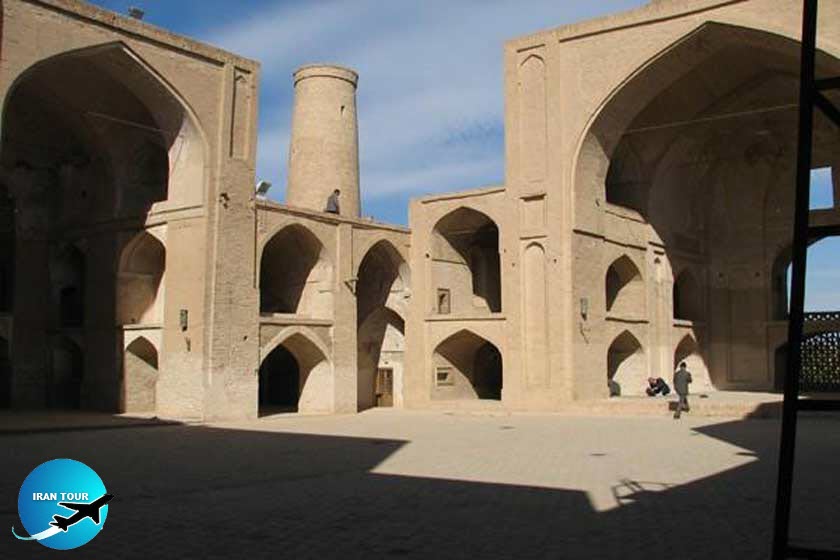 |
4-Isfahan Jame Atiq Mosque: A Living Architectural Museum
If you find yourself in Isfahan, Iran’s most famous tourism city, the Jame Atiq Mosque stands out as the finest Isfahan mosque and recognizes as UNESCO heritage sites among Isfahan historical treasures. A 1300 year-old mosque, is a living architectural museum, offers a remarkable destination for immersing yourself in the brilliant 1000-year-old history of Iranian-Islamic architecture. This extraordinary mosque not only captivates visitors but also makes a deep sense of reverence for its architects.
Why Atiq Jame Mosque
The Isfahan Atiq Jame Mosque embodies a rich history of Iranian-Islamic architecture while continuing to serve as a central place of worship. It serves as a testament to the dedication and skill of Iranian artists and craftsmen spanning a millennium. As a masterpiece of religious architecture, the mosque serves as a museum showcasing the artistic and architectural evolution across various periods. Visitors can witness the geometric elegance of the Seljuks juxtaposed with the more intricate designs of the Safavid era.
Spanning over 20,000 square meters, this mosque holds the distinction of being the largest in Iran.
What to see
-The Yard of the mosque: A vast yard(70x60) with four Ivan and two pond in the midle.
South Dome: This section dating back to the Seljuk era features 40 domes with 40 different designs.
North Dome: This Seljuk dome built in 1088 AD.
Darvish Ivan: This Ivan built in 1685, showcases decorations attributed to the Safavid ruler, Shah Suleiman.
Sahib Ivan: renowned as one of the most prominent structures from the Seljuk period.
Ostad Ivan: The west porch, known as Sofe Ostad, constructed during the Seljuk era and adorned with Safavid tile decorations.
Shagerd Ivan: It built during the Seljuk era, underwent reconstruction during the Ilkhanid and Safavid reigns.
Al-Jayto Mosque: a small winter mosque featuring an exquisite mihrab, renowned globally as a shining example of Iranian art.
Visitors can marvel at the intricate Iranian tiles, delicate plasterwork, ornate mosaics, and captivating moqarnas.
Architectural values of Isfahan Jame Mosque
The Isfahan Jame Mosque encapsulates centuries of mosque architectural evolution, in Iranian mosque design. As a result, it stands out in Iran architectural history, showcasing distinct styles from Iran and neighboring regions. Some notable architectural elements of the mosque include:
- Complicated crafted brick tiles adorned with geometric patterns.
- Brick columns featuring various sections, such as two-part, three-part, and four-part configurations achieved through creative combinations.
- Different ranges of architecture techniques.
- Four porches, each boasting unique decorations.
- Enormous domes characterized by innovative construction methods.
- Ornate and harmoniously adorned facades encircling the courtyard.
How to get there
This tempting mosque located near Naqsh Jahan square. You can easily access the mosque by taking the route through Qeisarieh Bazaar. Along this path from Naqsh-e Jahan Square to the Jame Atiq Mosque via Qeisarieh Bazaar, you have the opportunity to explore a variety of intriguing landmarks, including the Qeisarieh Bazaar, the historic Jarchi Mosque, the fascinating Assarkhaneh Shahi Museum, and numerous other cultural gems. The distance from Naqsh-e Jahan Square to Jame Atiq Mosque is 1800 meters, making it a convenient and enriching journey for enthusiasts of art and history.
Where to stay
Isfahan city offers a range of safe, comfortable, and budget-friendly accommodation options to cater to diverse preferences and needs.
The travelers who seeking luxury, the 5-star hotel, Abbasi and Chaharbagh hotels stand out as top choices, ensuring a lavish stay experience.
Alternatively, the 4-star hotels in Isfahan provide a balance of quality amenities and affordability, catering to various budgets and tastes.
The Isfahan 3-star hotels offering decent accommodations at a reasonable price point. This is a good cost-effective options to save costs.
If you are going to experience a unique and memorable lodging experience, Isfahan boutique hotels present charming and personalized stays to discover the art, history, architect and hospitality of Isfahan's people. This is a unique oriental experience that can't find in other places.
Finally, Isfahan hostels offer a budget-friendly choice without compromising safety or comfort, providing an ideal option for those looking to save on accommodation costs while enjoying a convenient and pleasant environment with appropriate services.
 |
5-Fahraj Jame Mosque: A Pure Islamic Mosque
Yazd desert City in the heart of Iran is the only registered city in UNESCO. This ancient city hosts a collection of the most beautiful and exciting historical monuments. It is the best tourist destination close Isfahan city(300 Km).The Yazd historical city, with its inteligent windmills(windcatchers) and deep Aqueducts(Qanats), has turned a large part of harsh desert region into a pleasant and beautiful place to live.
The unique historical monuments of Yazd, such as Zoroastrian fire temples, Jewish synagogues and beautiful Muslim mosques, are the most important signs of the peaceful life of different Iranian religions together.
Why you should visit Yazd city?
Yazd has various reasons that encourages you to visit it.
- Deep History.
- First Iranian UNESCO City.
- Unique Historical monuments.
- The Stunning desert Architecture.
- The motherland of Iranian Zoroastrians.
- Beautiful Houses and boutique House/Hotel.
- Qanats & Windcatchers.
- Hospitable people.
- Yazdi Sweets.
Fahraj Jame Mosque: A Pure Islamic Mosque
Among all Yazd historical monuments, the Jame Fahraj Mosque, stands out as one of the finest Arabic sample mosques. This Islamic - Arabic mosque captivates every visitor with its nice simple design and layout. It Regarded as the only mosque in the Islamic world with a rich history that has remained largely unchanged since its establishment.
Its architectural style and layout are refreshingly uncomplicated and constructed primarily with clay and mud. Its simplity exudes a sense of authenticity and antiquity. Upon entering the mosque, one will notice the absence of domes, inscriptions, tiling, and other conventional elements commonly found in the construction of mosques from later periods. The Jame Fahraj Mosque uniquely preserves its original aesthetic charm and historical significance.
How to get there
Fahraj City located 17 Km from Yazd. The Yazd daily excursion tours are the best solution to visit this mosque.
Yazd as one of the main tourist cities in Iran has various access.
Bus: The equipped Buses from main cities of Iran to Yazd are a safe and cheap soloution to visit this great city. There are regular scheduled bus timetables from the cities of Tehran, Isfahan, Shiraz, and Kerman to Yazd.
Fly: You can book your flight from Tehran to Yazd city.
Train: You can book your train ticket from Tehran, Isfahan, and Shiraz.
Where to stay
Fahraj City, located near Yazd, is a captivating tourist destination that can be explored through Yazd’s popular one-day tours. Yazd boasts a variety of accommodation options, including 5-star, 4-star, and 3-star hotels. You can book your desired hotel due to your budget.
The tourists who love history, art, architecture, and the enchanting oriental lifestyle, Yazd exquisite boutique hotels offer a unique and immersive experience.
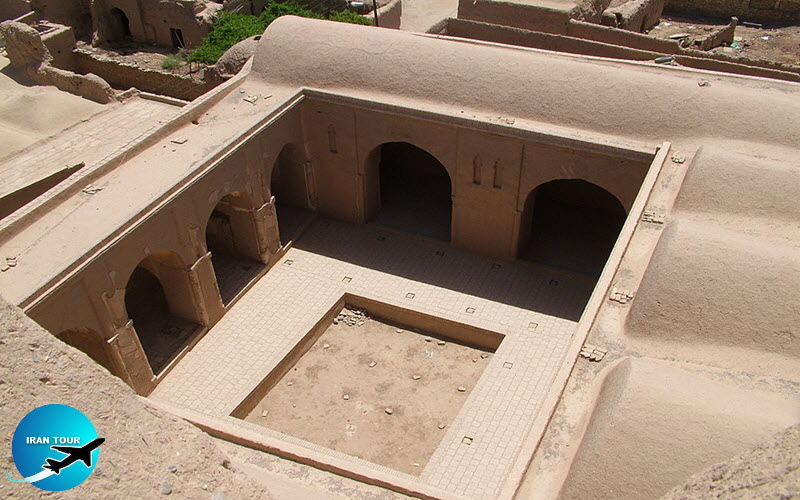 |
6-Varamin Jameh Mosque: A Showcase of Ilkhanid Era Architecture
Tehran city is one of the best tourist destinations in Iran with an exquisite collection of historical monuments. Visitors can explore ancient sites, like historical palaces, museums, bazaars, and art galleries, showcasing Tehran’s rich cultural heritage and historical architecture. Additionally, you can explore historical landmarks and monuments close Tehran, such as Abdul Azim’s Shrine, Toghrel Tower, and Gabri Castle in Rey city, they show you a deep part of Iran’s cultural and artistic history. Varamin Jame Mosque, 45 km Tehran, is one of the most beautiful Iran historical mosques, remnant from Mughals and Ilakhans era in Iran.
Why Varamin?
Varamin, located close Tehran(45 Km), hosts a treasure trove of historical sites and natural features, including archaeological sites, historical landmarks, cultural heritage, ancient ruins, historical architecture, monuments, and Varamin Desert. The Varamin Grand Mosque, a stunning remnant of the Mughals and Ilakhans era in Iran. You can mix the cultural, architectural and natural effects in one-day Varamin city tour.
What to see in Varamin
The tourist who seeking a blend of history and nature, Varamin is an ideal destination with these places:
- Historical castles.
- Varamin Grand Mosque (Ilkhani Period).
- Iraj castles (Sasanian period).
- Old Ice-house.
- Aladdin Castle (Ilkhani period).
- Varamin Desert.
What to see
Mosque building: an independent rectangular building with dimensions of 66 x 43 meters, a lasting legacy from the Mongol and Ilkhanate rule era in Iran.
Courtyard: A small quaint courtyard (25 x 25) surrounded by 4 charming Iwans.
Dome: Adorned with intricate plaster and tiling details, the 10 x 10 dome of the mosque showcases exceptional Ilkanid era craftsmanship.
Porches: The 4-Iwan plan of the courtyard boast exquisite Iranian-Islamic architectural embellishments, captivating visitors with their beauty.
The main entrance door: The head of the mosque is similar to the head entrance door of Natanz Jame Mosque and Mozafari Jame Mosque in Kerman.
Decorative Elements: Delicate plasterwork, detailed brickwork, symmetrical mosaics with slender and intricate patterns, and captivating turquoise and azure hues combine to create a visually enchanting experience for all visitors.
How to get there
A one-day excursion tour from Tehran let you to visit these huge amount of beauties. Our expert team helps you to arrange the best tour to visit the Varamin.
 |
7-Qazvin Jame Mosque: Seljuk Glory in the Safavid Capital
Qazvin City, located close to Tehran, is a captivating tourism destination boasting a plethora of historical sites and monuments that fall in love all visitors. While the city renowned for the Assassine or Alamut Castle, other historical remarkable structures, such as the Seljuk Jameh Mosque, Safavid monuments, Cantor or Kantur Christian church, and various other historical landmarks can amaze all visitors.
These architectural marvels embody the rich cultural heritage and historical architectural wonders of the Islamic era in Iran, showcasing the enduring legacy of Qazvin through its historical treasures, artifacts, and monumental structures. Explore the ancient sites and heritage sites in Qazvin to immerse yourself in the city’s architectural splendor and cultural significance.
Why Qazvin
- Deep History.
- Natural feauturs.
- Pleasent weather.
- Various delicious dishes.
- Different historical sites.
- As second Safavid Capital.
Qazvin Jame Mosque
The Qazvin Jame Mosque includes a collection of different and numerous architectural styles, from the Abbassid era to the Qajar kings. The oldest architectural parts back to the 2nd century AH. This building built on the remains of a Zoroastrian fire temple from the Sasanian period. This mosque has renovated in different historical periods. Qazvin Jame Mosque has a rich collection of different and numerous Abbassid era architectural styles to the Qajar kings.
This magnificent jame mosque situated on a former Zoroastrian fire temple from the Sasanian period. This historic mosque has undergone various renovations throughout different epochs, reflecting its enduring cultural and religious significance as a revered Islamic-era religious site.
What to see
Courtyard: The expansive courtyard of the mosque features a meticulously planned layout with four-Iwan.
Dome: An imposing turquoise dome, a relic from the Seljuk period, located in the southern part of the mosque.
Mihrab: A marble mihrab on south part, adorned with vibrant tiles and intricate plaster inscriptions.
Minarets: Rebuilt during the Qajar era, adding to its grandeur.
Harouni Arch: This arch located in the south of Mosque and built by the order of Haroun al-Rashid.
South Porch: The mosque’s most prominent and captivating feature, the two-story south porch, stands as a testament to its architectural beauty and significance.
Northern porch: Northern porch considered to be one of the buildings belonging to Shah Tahmasb Safavid period.
Northern Porch: Reflecting the Safavid era, and founded by the order of the Shah Tahmasb king.
Western porch: It built during the time of Shah Suleiman Safavid.
Decorations: The mosque’s adornments include exquisite Iranian-Islamic decorations such as delicate plasterwork, captivating tiling, intricate mosaics, and numerous inscriptions that narrate the rich history of the site.
How to get there
Qazvin city is a close important tourism destinaion to Tehran(140 Km). The different public Bus schadueled services from tehran to Qazvin city. You can book your ticket with US$ 2.
If you are eager to visit this historical city our expert team can arrange one-day tour program for you.
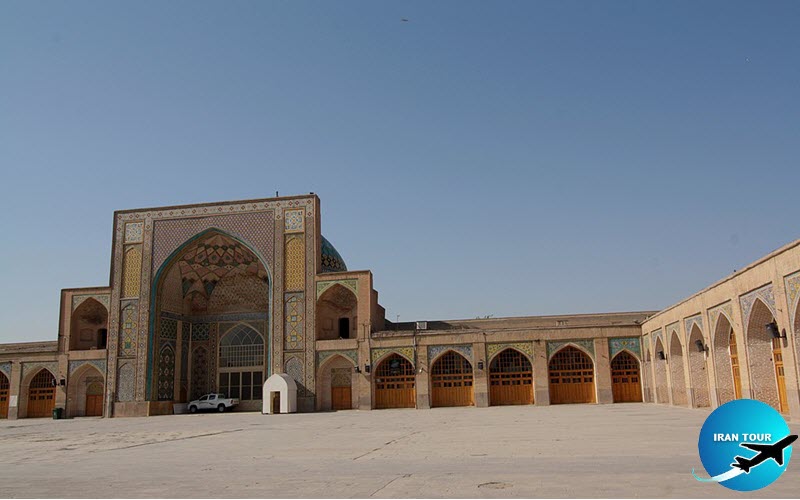 |
8- Farumad Jame Mosque: A Hidden Gem of Iranian Historical Mosques
If you have a passion for history, reading a historical book or watching a historical movie can only offer you a glimpse of the past. To truly immerse yourself in Iran's history, visiting the Farumad Jame Mosque is a must. If you are looking for Persian lost stories and are planning a trip to the Iran depths of history, stimulate your imagination. This is one of your best options.
Where is it
This majestic Jame mosque located 160 km from Shahroud City, Semnan Province, and is one of the top 10 Iranian valuable Jame mosques. Shahroud City, the second-largest city in Semnan Province, boasts a collection of spiritual monuments such as the Kharaghani Mausoleum (a famous Sufism leader), Bayazid Bastami's Shrine, and the Shahrokhie Theological Mosque, along with natural and historical sites that captivate visitors.
What to see
The mosque features exquisite stuccoes, deep vaults, and elaborate decorations from various periods, including the Khwarazmian dynasty, offering a journey through time. With a two-iwan layout, the mosque lacks a specific construction date marker. However, its resemblance to other two-iwan mosques in Khorasan suggests a link to the Khwarazmian dynasty. The north entrance gate is a highlight, adorned with intricate brickwork, stucco, and tablets. The South Mihrab is another marvel, adorned with turquoise and ultramarine stucco.
Although many parts of this magnificent mosque have been destroyed, the remaining delicate decorations of the mosque show the glory and grandeur of the prosperous era.
How to get there
Traveling to Farumad Jame Mosque is convenient with regular bus services from Tehran to Semnan and Shahroud, with bus tickets available from as low as $3.
Where to stay
For accommodation, Shahroud offers various hotels and eco-lodges to suit different preferences. Feel free to reach out to us for assistance in securing the best accommodation at a budget-friendly rate.
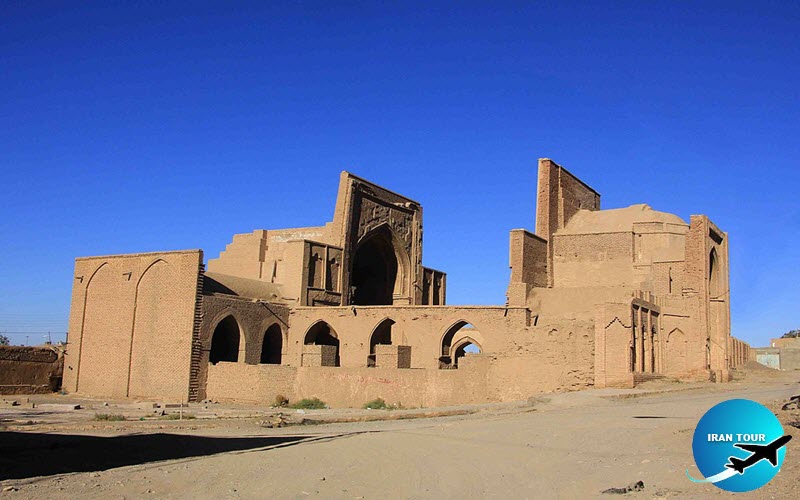 |
9-Neyriz Jame Mosque: A Fusion of Sassanid Heritage and Islamic Architecture
Neyriz Jame Mosque stands as one of the oldest and most unique mosques in Iran, showcasing a blend of art and religion within a Sassanid-inspired structure. It situated on the remnants of a Sassanid fire temple, adding to its historical significance.
Historical Background
Constructed with a single porch, the mosque’s remaining structure dates back to the Sassanid era, its records indicating that the porch built in 340 AH. Throughout its history, the mosque underwent several renovations and rebuilds during significant periods such as 460 AH, the Safavid era, and the Qajar dynasty.
What to see
The mosque is entered through a brick portal, which, via an anteroom and a vestibule, opens into a small, quadrangular courtyard.
Main Mihrab: The principal sanctuary consists of a crescent-shaped eivan, open on the south side and walled at the back. During the Sasanid period the Ivan served as a waiting room for those seeking an audience with the king, who was inside.
Stucco Mihrab: This is the most valuable feature of the mosque that decorated with fantastic plaster-works.
East & west Porches: On the east and west sides, the courtyard of the mosque lined with simple arcades.
How to Reach Neyriz
Located 220 km away from Shiraz, Neyriz city is accessible for those interested in exploring its historical sites. Visitors can easily organize a day tour from Shiraz to Neyriz to experience the rich heritage and architectural splendor of the Neyriz Jame Mosque and other significant landmarks in Fars Province.
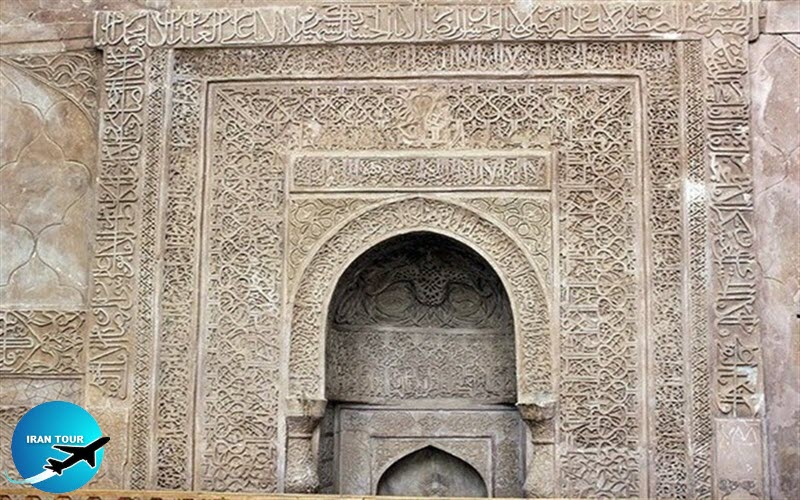 |
10- Shushtar Jameh Mosque: Remained from first Islamic period
Khuzestan Province, located in the southern region of Iran, stands out as a remarkable tourist destination boasting a diverse array of stunning historical sites. From ancient ruins to architectural wonders, the province is a treasure trove of Persian civilization and cultural heritage. Some of Khuzestan’s renowned historical monuments include the Choghazanbil Ziggurat, Dariush Palace, French Castle, Daniyal Nabi Mausoleum (Jewish Tomb), Shushtar Waterfalls, and Shushtar Jame Mosque. Noteworthy UNESCO World Heritage Sites in Khuzestan include the Choghazanbil Ziggurat and the Shushtar Waterfalls, adding to the province’s significance on a global scale. Explore the imperial tombs, sacred temples, and architectural marvels that showcase the essence of Khuzestan’s deep history.
Why Visit Shushtar?
Shushtar city, renowned for its profound historical background and remarkable monuments, stands out as a key tourist destination in Khuzestan province. The city’s historical treasures, including the innovative Shushtar water mills showcasing Iranian ingenuity, the iconic Sassanid bridges symbolizing Iran’s triumph over the Romans, and the majestic Shushtar Grand Mosque reflecting the fusion of Islamic influences with Iranian architectural styles.
History of Mosque
The Jameh Mosque of Shushtar located west of Shooshtar in the province of Khuzestan and is a vestige of the first Islamic period by the order of Abbasid Caliphates.
The Shushtar Jameh Mosque is a stunning example of Islamic architecture renovated by different rulers specifically the Safavid kings.
What to see
Courtyard: There are 12 brick colomns around the yard.
Altars: This mosque features two winter altars located inside the prayer hall, along with a summer altar positioned outside the mosque.
Shabestan: The mosque’s Shabestan area is supported by 48 stone pillars, with dome roofs elegantly spanning the space between the pillars.
Minaret: Situated on the eastern side of the mosque, remnants of a magnificent 8th-century minaret are still visible today. Only 16 meters of this once 26-meter-tall minaret remain, showcasing the architectural splendor of the past.
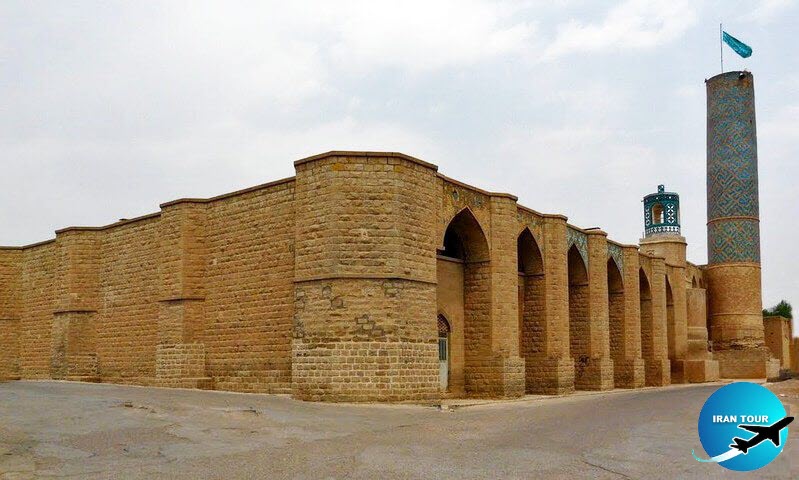 |
- Details
- Category: IRAN Blog